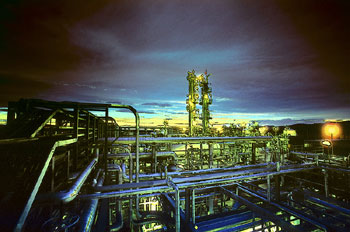|
| HOME | DEVELOPMENT & PRODUCTION | INDUSTRY PROJECTS | RESOURCES | DIRECTORY | SITE MAP |

|
Crude oil and natural gas resource development - Statistical Data Included
Total footage drilled in August 2002 was 12.8 million feet, 10 percent lower than the footage drilled in July 2002 and down 27 percent from that drilled in August 2001. The estimated number of exploratory and development crude oil and natural gas wells drilled during August 2002 was 1,757, down 2 percent from the number drilled in July 2002 and down 39 percent from the number drilled in August 2001. The estimated number of crude oil wells drilled was 376, and the estimated number of natural gas wells was 1,381, 46 percent lower and 36 percent lower, respectively, than their August 2001 levels. The estimated number of dry holes drilled in August 2002 was 305, down 2 percent from the number drilled in July 2002 and down 20 percent from the number drilled in August 2001. There were 1.9 thousand well service rigs active in August 2002, 3 percent higher than the previous month and 1 percent more than the count a year ago. The July 2002 active seismic crew count for the 48 States onshore was 19 percent lower than a year earlier while crew counts for the 48 States offshore were the same as a year earlier. Alaska reported 2 crews active in July 2002 compared with none a year earlier. No four-dimensional seismic crews have been active since December 2001. Crude Oil and Natural Gas Resource Development Notes Three well types are considered in the Monthly Energy Review (MER) drilling statistics: "completed for crude oil," "completed for natural gas," and "dry hole." Wells that productively encounter both crude oil and natural gas are categorized as "completed for crude oil." Both development wells and exploratory wells (new field wildcats, new pool tests, and extension tests) are included in the statistics. All other classes of wells drilled in connection with the search for producible hydrocarbons are excluded. Prior to the March 1985 MER, drilling statistics consisted of completion data for the above types and classes of wells as reported to the American Petroleum Institute (API) during a given month. Due to time lags between the date of well completion and the date of completion reporting to the API, as-reported well completions proved to be an inaccurate indicator of drilling activity. During 1982, for example, as-reported well completions rose, while the number of actual completions fell. Consequently, the drilling statistics published since the March 1985 MER are Energy Information Administration(EIA) estimates produced by statistically imputing well counts and footage based on the partial data available from the API. These estimates are subject to continuous revision as new data, some of which pertain to earlier months and years, become available. Additional information about the EIA estimation methodology may be found in "Estimating Well Completions," the feature article published in the March 1985 MER. Users of the well completion and footage figures published by the Energy Information Administration (EIA) prior to August 1998 should be aware that these data have been revised. The published well completion and footage figures are produced by the Well Completion Estimation Procedure (WELCOM) based on drilling records provided under contract to the EIA. Problems in the files received by EIA necessitated revision of the historical series for well completions and footage drilled.
|
Copyright 2025 Stenmar.com All rights reserved.
|

 The August 2002 rotary rig count was 848, slightly lower than the count in July 2002 and 32 percent lower than the count in August 2001. Of the total number of rigs in operation, 737 were onshore and 111 were offshore. For August 2002, the number of onshore rigs was down 33 percent and the number of offshore rigs was down 24 percent from the August 2001 count. Rotary rigs drilling for natural gas as a share of total rigs stood at 85 percent in August 2002.
The August 2002 rotary rig count was 848, slightly lower than the count in July 2002 and 32 percent lower than the count in August 2001. Of the total number of rigs in operation, 737 were onshore and 111 were offshore. For August 2002, the number of onshore rigs was down 33 percent and the number of offshore rigs was down 24 percent from the August 2001 count. Rotary rigs drilling for natural gas as a share of total rigs stood at 85 percent in August 2002.